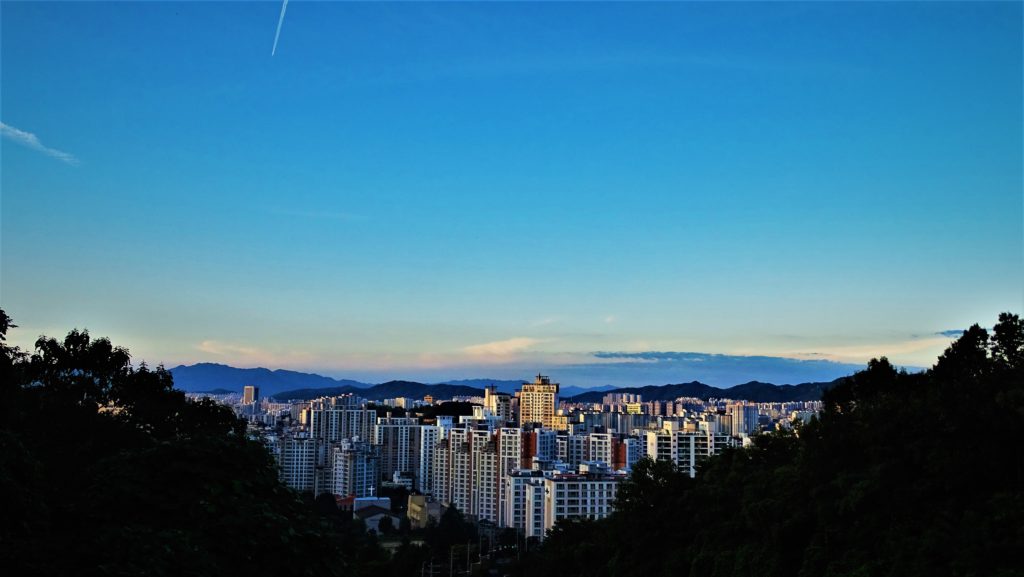The Tragic Beauty of Cloud Bridge
Written and photographed by Isaiah Winters
One of the best views of Gwangju is offered by Cloud Bridge (구름다리), a tied-arch pedestrian overpass located in Bongseon-dong, Nam-gu. The narrow, 37-meter-high bridge was built to connect the hiking trails that run along the ridges of Jeseok Mountain (제석산). Day or night, it’s a great place to get some fresh air and enjoy a unique view of Gwangju’s dense cityscape cropped by mountain slopes. The bridge is especially attractive at night as it’s colorfully lit yet eerily quiet, making it an ideal place for nocturnal couples to enjoy the City of Light from a more reclusive vantage point. The bridge’s year-round 24-hour access is another notable feature, as most other sites offering comparable views are either time-restricted or harder to reach.
As appealing as all this may sound, Cloud Bridge’s height and accessibility aren’t without their downsides. For instance, in March of 2017, a 119 rescue team had to rush to the bridge in response to an early morning suicide alert. Thirty-five minutes before it was too late, the team encountered a 24-year-old man who reportedly suffered from financial and mental difficulties. Despite the rescue team’s efforts to help, the man took the tragic plunge anyway, avoiding the air mat stretched out below, and died at the scene. Compounding the tragedy, later that same day, the man’s 26-year-old lover also fell to her death from the same bridge.[1] Sadly, more than a few others have used this location to take their own lives, something that makes Cloud Bridge’s role in suicide prevention a worthwhile topic.

The good news is that uplifting signs with phone numbers for emergency services, 24-hour crisis counseling, and the Namgu Community Health Center’s Mental Health Promotion Center are amply posted in the area. (I counted six such notices along two of the staircases leading to the bridge.) Given the area’s heavy foot traffic, these signs provide good Samaritans the opportunity to report any unusual behavior, something that’s no doubt saved lives. A few years back, I was “saved” by just such a concerned citizen in Romania when I was spotted climbing the façade scaffolding of a certain high-profile building (for photographic purposes, naturally). As I had my earbuds in with music blaring, it wasn’t until I reached the top that I noticed a half dozen emergency vehicles down below. The police later told me that a passerby thought I was going to jump and so immediately phoned emergency services. Needless to say, I’ve become a bit less adventurous since then.
In addition to Cloud Bridge’s many existing signs, the area might benefit from having actual phones that directly contact such services, especially 24-hour crisis counselors. As almost everyone has cellphones these days, such phone installations would be less for concerned citizens and more for the potentially suicidal who might want someone to talk to. A good place to put one such phone would be between the two benches at the foot of the main staircase leading to the bridge. It might also be good to flank the bridge itself with two such phones. Another idea, albeit an expensive one, would be to install safety netting beneath the bridge’s deck. Although such a fixture would certainly affect the bridge’s aesthetics, the picturesque views wouldn’t be affected at all, as there’s nothing to see directly under Cloud Bridge except an uninspiring two-lane road and some foliage.

These pipe dreams aside, what’s for certain is that suicide in Gwangju (and in Korea generally) is and will continue to be an issue in need of greater attention. Fortunately, in April of this year, the Gwangju Mental Health and Welfare Center (광주정신건강복지센터) and its affiliated Suicide Prevention Center (자살예방센터) released the results of a five-year analysis on suicide in Gwangju spanning the years 2012–2016.[2] At first glance, what surprised me most about the data was just how evenly distributed suicide is across the age spectrum in Gwangju, with those in their 30s, 40s, 50s, and over the age of 70 each accounting for roughly 20 percent of suicides. Those in their 20s and 60s accounted for about ten percent each, while those in their teens accounted for just under three percent. (Feel free to consult the analysis for the exact figures.)
The research also revealed that for each of these age brackets, there are particular stressors that are more likely to provoke suicide attempts. For those in their 30s and over the age of 50, family discord was the major impetus for attempted suicide. For those in their 40s, economic difficulties were the driving factor, while for those in their teens and 20s, relationship-related problems were the main motivating factor involved. However, the one commonality that was found equally across all age groups was the presence of mental health issues, which was involved in about half of all suicide attempts recorded.

Another finding that stood out was the gender disparity that comes with suicidal behavior. Of the total 1,702 people who committed suicide in Gwangju during 2012–2016, about 70 percent were men and 30 percent were women. Interestingly, the analysis found that this gender imbalance reversed a bit when it came strictly to suicide attempts, with women attempting suicide more often than men. The results also showed that although the men attempted suicide less than the women, the former’s suicide intent was more likely to prove fatal. Apparently, broadly similar gender disparities in suicide can be found globally.
If you or someone you know is in need of help, read Josh Garcia’s Gwangju News article “Breaking the Silence: Mental Healthcare Access in Gwangju,” which links to a few local resources for English-language counseling.[3] For more urgent situations, dialing 119 is probably the best English-language option.
I’ll end this piece with what I think is the most poignant quote found at Cloud Bridge: “Did you eat today? Are you dressed now? Do you have a place to sleep? Then it’s okay. You’re already rich.”
Sources
[1]: Yonhap News. (2017, March 23). 광주 제석산 구름다리서 20대 남녀 잇따라 극단 선택. Retrieved from the Maeil Business Newspaper website: http://news.mk.co.kr/newsRead.php?sc=50400002&year=2017&no=197217
[2]: Song Hyeong-il. (2018, April 13). 광주자살예방센터 “30∼40대가 가장 많이 생을 접었다. Retrieved from the Yonhap News website: http://www.yonhapnews.co.kr/local/2018/04/13/0805010000AKR20180413064800054.HTML
[3]: Garcia, J. (2017, July 26). Breaking the silence: Mental healthcare access in Gwangju. Retrieved from the Gwangju News website: https://gwangjunewsgic.com/community/health/mental-healthcare-access/
The Author
Originally from Southern California, Isaiah Winters first came to Gwangju in 2010. He recently returned to South Korea after completing his MA in Eastern Europe and is currently the chief proofreader for the Gwangju News. He enjoys writing, political science, and urban exploring.





